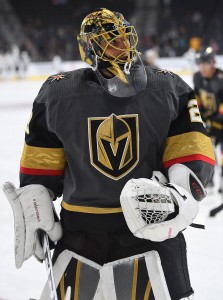The Pittsburgh Penguins have a lot invested in their goaltender of the present and future in Matt Murray. You would think replacing Marc-Andre Fleury might be a challenging procedure, but Murray’s .923 save percentage in 49 games proved that the youngster was ready for the full-time role, one of the reasons why it wasn’t as hard to let Fleury go. However, last year’s struggles already has several fans worried about Murray’s long-term success.
Murray struggled with both injuries as well as the death of his father during the 2017-18 season in which he still played in 49 games, but didn’t fare as well, posting a .907 save percentage as well as a 2.92 GAA. However, Murray as well as the team’s other backups, Casey DeSmith and Tristan Jarry, have worked hard with goaltending coach Mike Buckley, who challenged each one of them, according to Jason Mackey of the Pittsburgh Post-Gazette.
Buckley feels that Murray has put too much pressure on himself to replace Fleury and needs to accept that he’s the “guy” now.
“The next step for him is to take it all in and enjoy it. ‘Hey, I’m the guy now. I can accept that. I don’t have to be Marc-Andre Fleury, but I can be tighter with my teammates and really open up to them.’” Buckley said.
Buckley added that Murray has worked hard on his conditioning and hopefully should be able to avoid injury, although some injuries like concussions are just unavoidable.
“In terms of how he takes care of his body, he’s meticulous,” Buckley said. “The problem is the things that you can’t control. A concussion, for example. Someone coming down and landing on you the wrong way. There’s really very little you can do about that.”
- Sam Carchidi of philly.com writes that Philadelphia Flyers general manager Ron Hextall says that No. 1 center Sean Couturier will be “absolutely” 100 percent at the start of the season in October and is already ready to resume skating. Couturier, who was expected to miss four weeks on Aug. 22 with a lower-body injury, is coming off a career-best season in which he scored 31 goals and 76 points and was a key part to the Flyers’ late-season success on a line with Claude Giroux and Travis Konecny.
- Shayna Goldman of The Athletic (subscription required) writes that this will be a challenging season for New York Rangers goaltender Henrik Lundqvist, who is coming off two poor seasons and now finds himself in the middle of a rebuilding project. Lundqvist has endured a very physical workload over the course of his career and didn’t get significant rest last season from then-head coach Alain Vigneault. One thing is imperative. The 36-year-old needs rest, which will be a key for new head coach David Quinn. The problem is that the team lacks an adequate backup as the no longer have either Cam Talbot or Antti Raanta serving behind him. The team now has a number of prospects, including Alexandar Georgiev, Dustin Tokarski and Marek Mazanec. However, unless one of them can step up, none seem likely to provide Lundqvist the kind of rest that he needs.
- With the possibility that the team could lose star goaltender Sergei Bobrovsky to another team when he hits free agency next season, the Columbus Blue Jackets are placing more emphasis on the future suddenly, according to Aaron Portzline of The Athletic (subscription required). While the team has their immediate goaltender of the future in their backup Joonas Korpisalo, the team is focusing their long-term hopes on Elvis Merzlikins, their third-round pick in 2014, who has been a dominant prospect for Lugano of the Swiss League. The 24-year-old has been one of the top goaltenders in the league, posting a .924 save percentage last year and is ready to come to North America next season.


